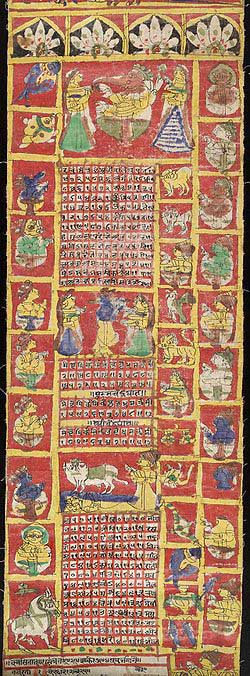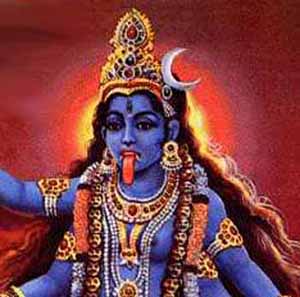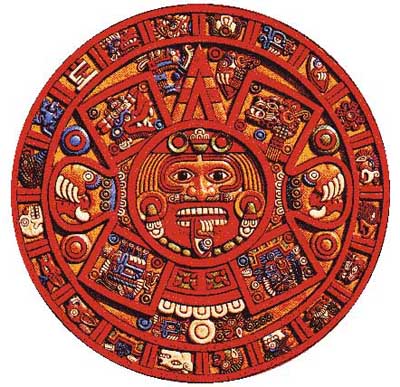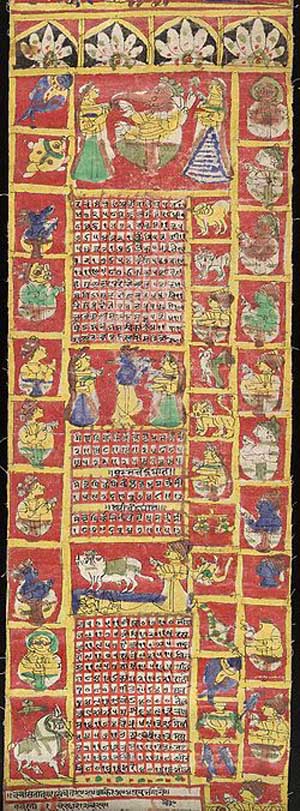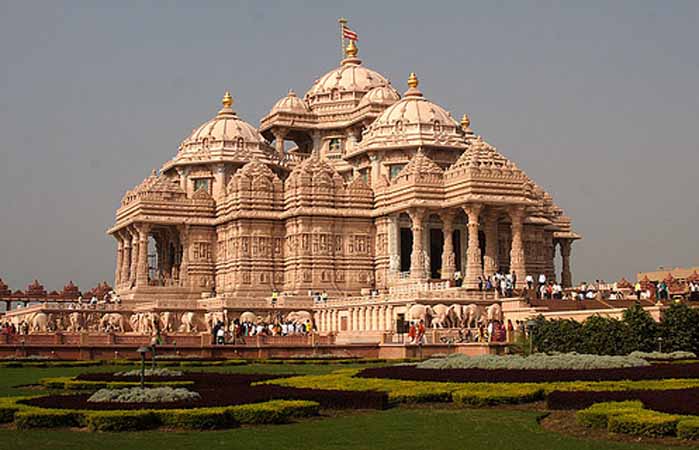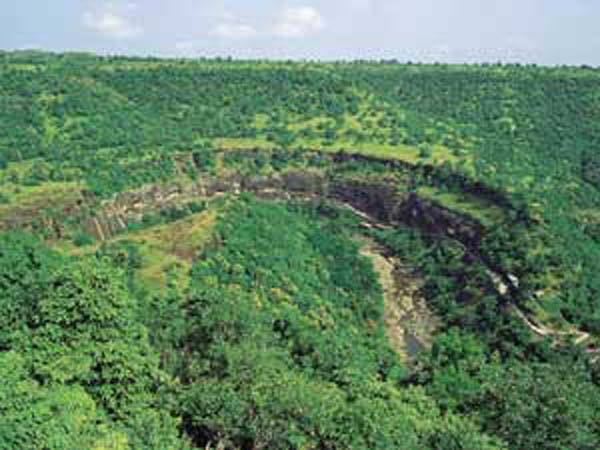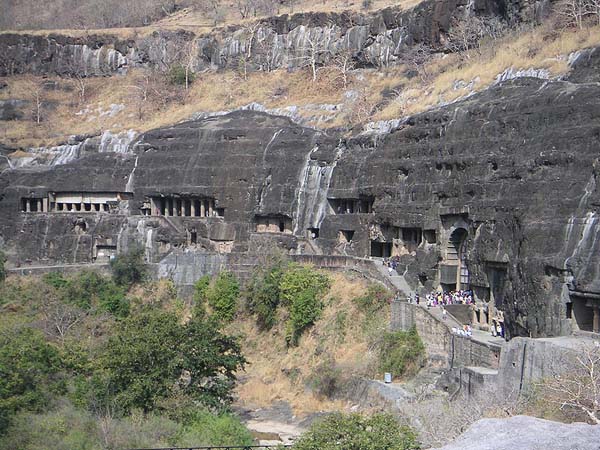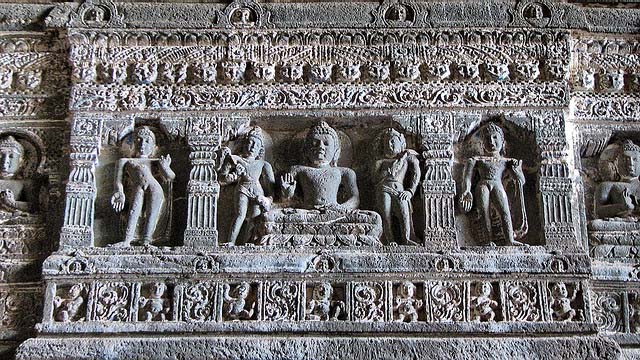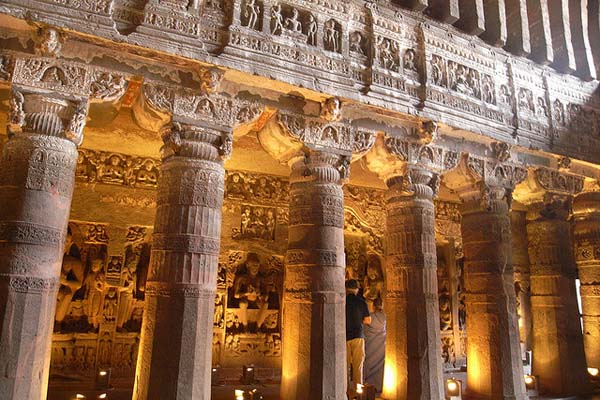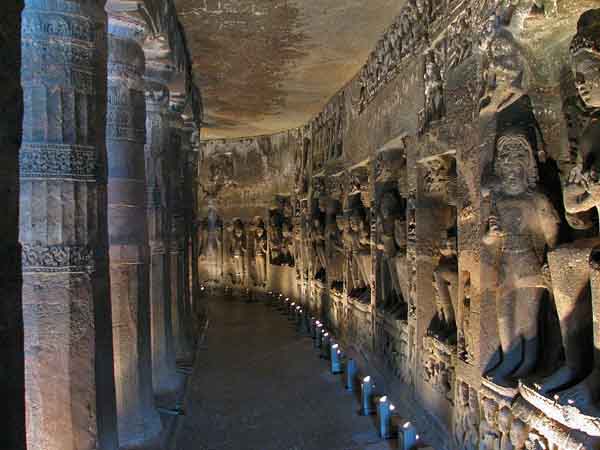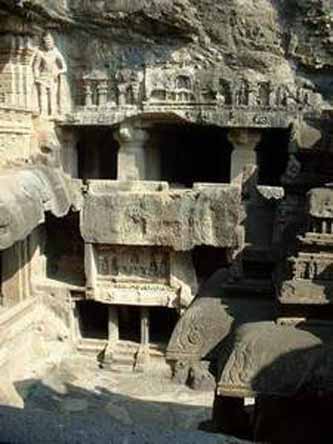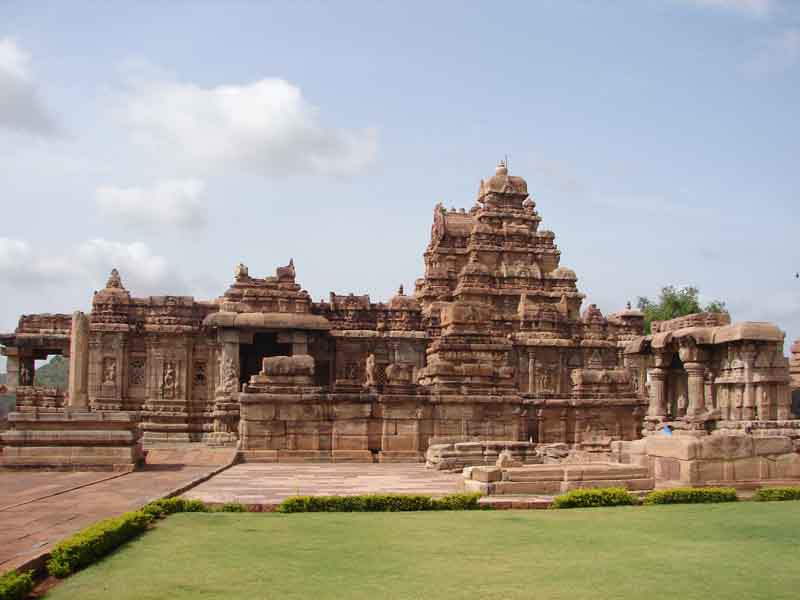History of India
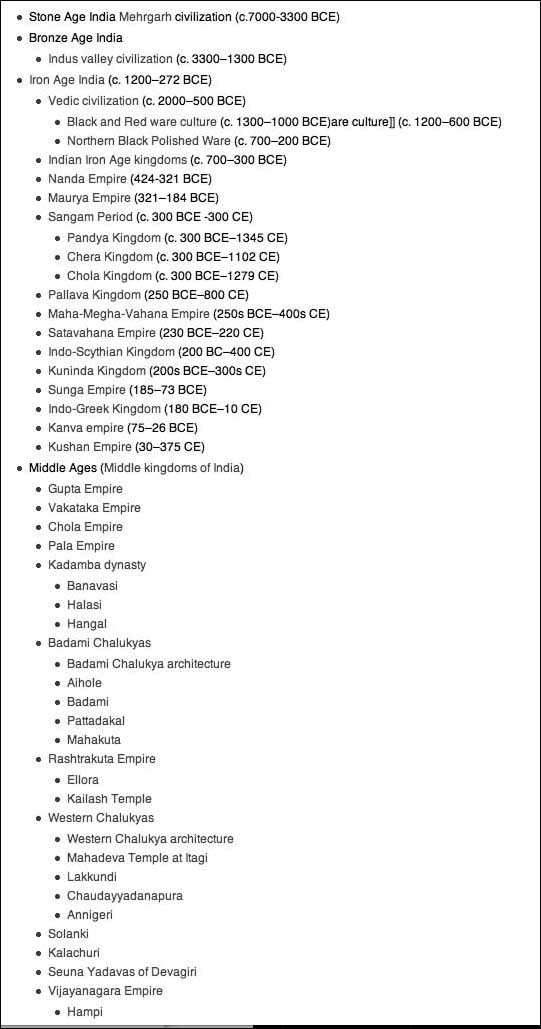
The History of India can be traced in fragments to as far back as 700,000 years ago. The Indus Valley Civilization, one of the oldest in the world, dates back at least 5,000 years.
According to the Indo-Aryan migration hypothesis, the Aryans, a nomadic people, possibly from Central Asia or northern Iran migrated into the north-west regions of the Indian subcontinent between 2000 BCE and 1500 BCE.
Their inter-mingling with the earlier Dravidian cultures apparently resulted in classical Indian culture as we know today.
The births of Mahavira and Buddha around 550 BCE mark the beginning of well-recorded Indian history.
For the next 1500 years, India produced its classical civilisation, and is estimated to have had the largest economy of the ancient world between the 1st and 15th centuries AD, controlling between one third and one fourth of the world's wealth up to the time of the Mughals, from whence it rapidly declined during European rule.
Incursions by Arab and Central Asian armies in the 8th and 12th centuries were followed by inroads by traders from Europe, beginning in the late 15th century. By the middle of the 19th century (1858), the British Crown had assumed political control over virtually all of India. Indian armed forces in the British army played a vital role in both the World Wars.
Nonviolent resistance to British colonialism led, by Mohandas Gandhi, Vallabhbhai Patel and Jawaharlal Nehru brought independence in 1947. The subcontinent was partitioned into the Secular Democratic Republic of India and the smaller Islamic Republic of Pakistan. A war between the two countries in 1971 resulted in East Pakistan becoming the separate nation of Bangladesh. In the 21st century, India has made impressive gains in economic investment and output, and stands as the world's largest democracy with a population exceeding 1 billion, is self sufficient in terms of food, and is a fast-growing, economically strong country.
Human civilizations in India are some of the earliest recorded, and were equal contemporaries of civilizations in ancient Mesopotamia and Egypt. India's history essentially includes all of the Indian subcontinent, including the more recent nations of Pakistan and Bangladesh. India is also inalienably linked with the history and heritage of the other geographically South Asian nations like Sri Lanka, Nepal and Bhutan, and India's culture, economy and politics has influenced, and has been influenced in turn, by the history and culture of the nations in South East Asia, East Asia and Central Asia, such as Bali, Cambodia, Thailand, Burma, China, Tibet, Persia and Afghanistan, over thousands of years.
After Arab incursions into India during the early part of the 2nd Millenium AD, similar quests for access to India's fabled wealth strongly influenced the history of medieval Europe, after the landing of Vasco Da Gama. Christopher Columbus discovered America whilst seaching for a new route to India, and the British Empire gained much of its resources after the incorporation of India as the 'Jewel in the Crown', from the 1700s to 1947.
The Paleolithic Era
Isolated remains of Homo Erectus in Hathnora in the Narmada Valley in Central India indicate that India might have been inhabited since atleast the Middle Pleistocene era [1]. The precise date of these remains is unclear, and archaeologists put it anywhere between 200,000 to 500,000 years [2]. The fossils are the earliest human remains found in South Asia. Recent finds include a quarry along the Malaprabha and Ghataprabha rivers in the Kaladgi Basin in Karnataka. Modern humans seem to have settled the subcontinent towards the end of the last Ice Age about 12,000 years ago. The first confirmed permanent settlements appeared 9,000 years ago in Bhimbetka in modern Madhya Pradesh.
The Neolithic Era
The early Neolithic culture in South Asia is represented by the Mehrgarh culture which began in 7000 BC, now in Baluchistan, Pakistan. The Mehrgarh community were mostly pastoral, lived in mud houses, wove baskets and tended to goats and their farms. By 5500 BC, pottery began to appear and later chalcolithic implements began to appear. By 2000 BC, the settlement was abandoned.
Late Neolithic cultures sprang up in the Indus Valley region between 6000 BC and 2000 BC (see below), and in southern India between 2800 BC and 1200 BC.
The Bronze Age
Indus Valley Civilization
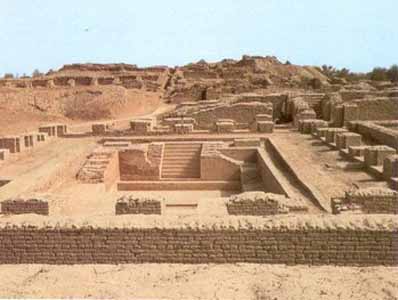
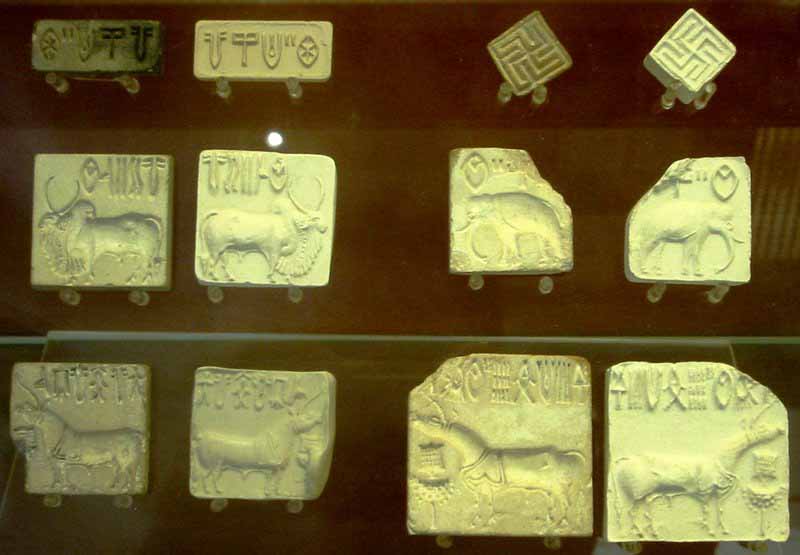
Indus Valley Seals
The transition of settlements from agricultural to complex urban communities, a salient feature of all late Neolithic and early Bronze Age cultures, occurred in the Indian subcontinent sometime between the early settlements at Mehrgarh and c. 3300 BC. This period marked the beginning of the earliest urban society in India, known as the Indus Valley Civilization (or, the Harappan Civilization), which thrived between 3300 BC and 1900 BC. It was centred along the Indus River and its tributaries, including the Ghaggar-Hakra River, and extended into the Ganges-Yamuna Doab, Gujarat, and northern Afghanistan.
The civilization is noted for its cities built of brick, road-side drainage system and multi-storeyed houses. The earliest historic references to India may be those to the Meluhha in Sumerian records, possibly referring to the Indus Valley civilization. When compared to the contemporary civilizations of Egypt and Sumeria, the Indus Civilization possessed unique urban planning techniques, covered the largest geographical area, and may have been a single state, as suggested by the amazing uniformity of its measurement systems.
The Mohenjo-daro ruins were once the centre of this ancient society. Indus Civilization settlements spread as far south as present-day Bombay, as far east as Delhi, as far west as the Iranian border, and as far north as the Himalayas. Among the settlements were the major urban centres of Harappa and Mohenjo-daro, as well as Dholavira, Ganweriwala, Lothal, Kalibanga and Rakhigarhi. At its peak, some archaeologists opine that the Indus Civilization may have had a population of well over five million.
To date, over 2,500 cities and settlements have been found, mainly in the general region to the east of the Indus River in Pakistan along what is claimed by many to be the Saraswati River mentioned in the Vedas. It is thought by some that geological disturbances and climate change, leading to a gradual deforestization may ultimately have contributed to the civilization's downfall.
Archaeological resources suggest that the diverse geography of ancient India was increasing in the amount and specialization of faunal remains around 2400 to 1500 BC. This specialization suggests that the Indus Valley Civilizations were dependent upon the alluvial soils of the rivers, which produced high yield crops. By 2600 BC, the presence of a state level society is evident, complete with hierarchical rule and large scale public works. These include accomplishments such as irrigation, warehouses for grain, public streets, and brick-lined drainage systems for sanitation. Around the mid 2nd millennium BC, the region of the Indus River basin, in which approximately two-thirds of currently known sites were located dried up, and the sites were abandoned.
Vedic Civilization
The Vedic civilization is the Indo-Aryan culture associated with the Vedas, which are some of the oldest extant Indo-European texts, orally composed in Vedic Sanskrit. But this is a misconception for the simple reason that vedas were the earliest text that originated in India. The exact connection of the genesis of this civilization with the Indus Valley civilization on one hand, and a possible Indo-Aryan migration on the other hand, is the subject of disputes. Early Vedic society was largely pastoral. After the Rigveda, the society became increasingly agricultural, and was organized around four Varnas, or classes. Several small kingdoms and tribes merged to form a few large ones, such as the Kuru and Panchala, some of which were often at war with each other.
In addition to the principle texts of Hinduism, (the Vedas), the great Indian epics, the Ramayana and Mahabharata, the latter of which constitutes the longest poem in the world after the Kyrgyz Manas, are said to have their ultimate origins during this period, from an oral tradition of unwritten Bardic recitation. The Bhagavad Gita, another primary text of Hinduism, is contained within the Mahabharata.
Early Indo-Aryan presence probably corresponds, in part, to Ochre Coloured Pottery, archaeologically. The kingdom of the Kurus marks flowering of the Vedic civilization, corresponding to the Black and Red Ware and the beginning of the Iron Age in Northwestern India begins, around 1000 BC, likely also contemporary with the composition of the Atharvaveda. Painted Grey Ware spread over much of Northern India marks the Middle Vedic period, followed by a wave of urbanization that occurred across the Indian sub-continent, from Afghanistan to Bengal, in the 6th century BC. A number of kingdoms and oligarchies, often called republics, emerged across the Indo-Gangetic plain and the northern part of South India during this period. 16 of them, called Mahajanapadas (great lands), are referred to in the ancient literature of the period.
Mahajanapadas
By 500 BC, sixteen monarchies and 'republics' known as the Mahajanapadas stretched across the Indo-Gangetic plains from modern-day Afghanistan to Bangladesh. The largest of these nations were Magadha, Kosala, Kuru and Gandhara. The right of a king to his throne, no matter how it was gained, was usually legitimized through religious right and genealogies concocted by priests who ascribed divine origins to the rulers.
Hindu rituals at that time were complicated and conducted by the priestly class. It is thought that the Upanishads, late Vedic texts dealing mainly with incipient philosophy, were first composed early in this period. The educated speech at that time was Sanskrit, while the dialects of the general population of northern India were referred to as Prakrits. In 537 BC, Gautama Buddha gained enlightenment and founded Buddhism, which was initially intended as a supplement to the existing Vedic dharma. Around the same time period, in mid-6th century BC, Mahavira founded Jainism.
Both religions had a simple doctrine, and were preached in Prakrit, which helped it gain acceptance amongst the masses. While the geographic impact of Jainism was limited, Buddhist nuns and monks eventually spread the teachings of Buddha to Central Asia, East Asia, Tibet, Sri Lanka and South East Asia.
Much of the northwestern Indian Subcontinent (present day Eastern Afghanistan and most of Pakistan) was ruled by the Persian Achaemenid Empire from c. 520 BC during the reign of Darius the Great, up intil its conquest by Alexander the Great. Lands in present-day Punjab, the Indus river from the borders of Gandhara down to the Arabian Sea, and some other parts of the Indus plain, became a satrapy of Alexander's empire. According to Herodotus of Halicarnassus, it was the most populous and richest of all the twenty satrapies of the empire. Achaemenid rule lasted about 186 years. The Achaemenids used the Aramaic script for the Persian language. After the end of Achaemenid rule, the use of Aramaic in the Indus plain diminished, although we know from inscriptions from the time of Emperor Asoka that it was still in use two centuries later. Other scripts, such as Kharosthi (a script derived from Aramaic) and Greek became more common after the arrival of Alexander the Great.
Alexander the Great
The interaction between Hellenistic Greece and Buddhism began when Alexander the Great conquered Asia Minor and the Achaemenid Empire, reaching the north west frontiers of the Indian subcontinent in 334 BC. There, he defeated King Puru in the Battle of the Hydaspes (near modern-day Jhelum, Pakistan) and conquered much of the Punjab. However, Alexander's troops refused to go beyond the Beas river, and he was forced to march his army southwest.
Alexander created garrisons for his troops in his new territories, and founded several cities in the areas of the Oxus, Arachosia, and Bactria, and Macedonian/Greek settlements in Gandhara and the Punjab. The regions included the Khyber Pass - a geographical passageway south of the Himalayas and the Hindu Kush mountains - and the Bolan Pass, on a trade route connecting Drangiana, Arachosia and other Persian and Central Asian kingdoms to the lower Indus plain. It is through these regions that most of the interaction between South Asia and Central Asia took place, generating intense cultural exchange and trade.
Greco-Buddhist Period
Greco-Buddhism, sometimes spelled Gr¾co-Buddhism, is the cultural syncretism between the culture of Classical Greece and Buddhism, which developed over a period of close to 800 years in the area corresponding to modern-day Afghanistan and Pakistan, between the 4th century BC and the 5th century AD. Greco-Buddhism especially influenced the artistic development of Mahayana Buddhism, before it was adopted by Central and Northeastern Asia from the 1st century AD, ultimately spreading to China, Korea and Japan.
Amongst the 16 Mahajanapadas, the kingdom of Magadha rose to prominence under a number of dynasties that peaked in power under the reign of Asoka Maurya, one of India's most legendary and famous emperors. The kingdom of Magadha had emerged as a major power following the subjugation of two neighboring kingdoms, and possessed an unparalleled military.
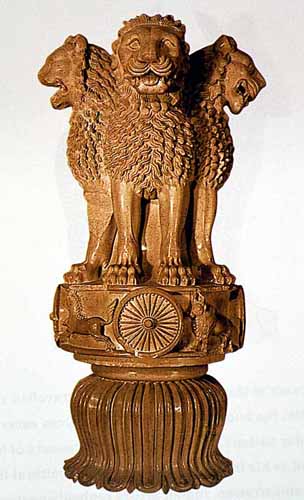
Shishunaga Dynasty
According to tradition, the Shishunaga dynasty founded the Magadha Empire in 684 BC, whose capital was Rajagriha, later Pataliputra, near the present day Patna. This dynasty lasted till 424 BC, when it was overthrown by the Nanda dynasty. This period saw the development of two of India's major religions. Gautama Buddha in the 6th or 5th century BC was the founder of Buddhism, which later spread to East Asia and South-East Asia, while Mahavira founded Jainism.
Nanda Dynasty
Nanda dynasty was established by an illegitimate son of the king Mahanandin of the previous Shishunaga dynasty. Mahapadma Nanda died at the age of 88 and, therefore, he ruled the bulk of the period of this dynasty, which lasted 100 years. The Nandas were followed by the Maurya dynasty.
The first Nanda, the Mahapadma Nanda has been described as the destroyer of all the Kshatriyas. He defeated Ikshvakus, Panchalas, Kasis, Harhayas, Kalingas, Asmakas, Kurus, Maithilas, Surasenas, Vitihotras, etc.,. He expanded his territory till south of Deccan. The last of the Nandas was Dhana Nanda. Plutarch tells that Chandragupta Maurya had stated that Nanda was hated and despised by his subject on account of the wickedness of his disposition. The bloody fight between the Nandas and the Mauryas overthrew the dynasty of Nandas.
The Nandas who usurped the throne of the Shishunaga dynasty were of low origin. Some sources state that the founder, Mahapadma , was the son of a Shudra mother, others that he was born of a union of a barber with a courtesan. Nandas were the first of a number of dynasties of northern India who were of non-kshatriya origin.The Nandas are sometimes described as the first empire builders of India. They inherited the large kingdom of Magadha and wished to extend it to yet more distant frontiers. To this purpose they built up a vast army consisting of 20,000 cavalry, 200,000 infantry, 2,000 chariots and 3,000 elephants. But the Nandas never had the opportunity to use this army against the Greeks, who invaded India at the time Dhana Nanda, since Alexander's campaign terminated in the Punjab.
The Nandas made the methodical collection of taxes by regularly appointed officials a part of their administrative system. The treasury was continually replenished, the wealth of the Nandas being well-known. The Nandas also built canals and carried out irrigation projects. The possibility of an imperial structure based on an essentially agrarian economy began to germinate in the Indian mind. But further development of the Nandas was cut short by Chandragupta Maurya and his mentor Chanakya. Chanakya dethroned Dhana Nanda in a battle of wits and replaced him with Chandragupta Maurya, a young adventurer. Dhana Nanda was murdered which finally signaled the advent of the Mauryan era in 321 B.C.
Maurya Dynasty
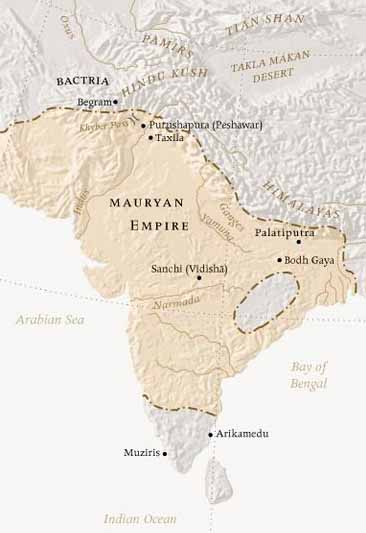
In 321 BC, exiled general Chandragupta Maurya founded the Maurya dynasty after overthrowing the reigning king Dhana Nanda to establish the Mauryan Empire. Chandragupta was succeeded by his son Bindusara, who expanded the kingdom over most of present day India, barring the extreme south and east. During this time, most of the subcontinent was united under a single government for the first time.
The kingdom was inherited by his son Ashoka The Great who initially sought to expand his kingdom. In the aftermath of the carnage caused in the invasion of Kalinga, he renounced bloodshed and pursued a policy of non-violence or ahimsa after converting to Buddhism. The Edicts of Ashoka are the oldest preserved historical documents of India, and from Ashoka's time, approximate dating of dynasties becomes possible. The Mauryan dynasty under Ashoka was responsible for the proliferation of Buddhist ideals across the whole of East Asia and South-East Asia, fundamentally altering the history and development of Asia as a whole. Ashoka the Great has been described as one of the greatest rulers the world has seen.
Shunga Dynasty
The Sunga dynasty ruled the Sunga empire of central and eastern India from 185 BCE to around 73 BCE. The last ruler of the Mauryan dynasty was Brhadrata. He was killed by his own commander-in-chief Pusyamitra Sunga in 185 BCE. With the fall of Mauryas, India lost its political unity. Pushyamitra Sunga became the ruler of the Magadha and neighbouring territories. The north-western regions comprising Rajputana, Malwa and Punjab passed into the hands of the foreign rulers. The kingdom of Pushyamitra was extended upto Narmada in the south, and controlled Jalandhar and Sialkot in the Punjab in the north-western regions. Pushyamitra died after ruling for 36 years (187-151 BCE). He was succeeded by son Agnimitra. This prince is the hero of a famous drama by one of India's greatest playwright, Kalidasa. Agnimitra used to hold his court in the city of Vidisa, modern Besnagar in Eastern Malwa. The power of the Sungas gradually weakened. It is said that there were ten Sunga kings.
The middle period, especially that associated with the Gupta dynasty, is known as India's Golden Age, a time of unparalleled cultural development. The Kushanas invaded northwestern India about the middle of the 1st century CE, from Central Asia, and founded an empire that eventually stretched from Peshawar to the middle Ganges and, perhaps, as far as the Bay of Bengal. It also included ancient Bactria (in the north of modern Afghanistan) and southern Tajikistan. Their power also extended into Turkestan and helped spread Buddhism to China. In South India, several kingdoms emerged.
The earliest of these is the Pandya kingdom in southern Tamil Nadu, with its capital at Madurai. The Indo-Greek Kingdoms following the conquests of Alexander the Great ruled much of Gandhara from 180 BC to 10 CE. Around the same time in southern India, the Dravidian Pandyan kingdom began to take shape. An important source for the geography and history of that period is the Greek historian Arrian.
Satavahana Empire
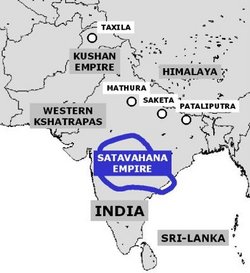
The Satavahanas, also known as the Andhras, were a dynasty which ruled in Southern and Central India starting from around 230 BC. Although there is some controversy about when the dynasty came to an end, the most liberal estimates are of about 450 years. Long before that their kingdom had disintegrated into successor states. Conflict with the Sakas and the rising ambitions of their feudatories, led to their decline. Several dynasties divided the lands of the kingdom among themselves.
Kushan Empire
The Kushan Empire (c. 1stÐ3rd centuries) was a state that at its height, about 105Ð250, stretched from Tajikistan to the Caspian Sea to Afghanistan and down into the Ganges river valley. The empire was created by Tocharians from modern East Turkestan, China, but was culturally dominated by north India. They had diplomatic contacts with Rome, Sassanian Persia and China, and for several centuries were at the centre of exchange between the East and the West, spreading Buddhism through trade with China.
Gupta Dynasty
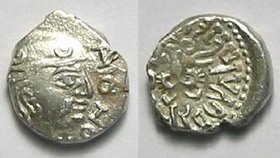
In the 4th and 5th centuries, the Gupta Dynasty unified northern India. During this period, known as India's Golden Age, Hindu culture, science and political administration reached new heights. After the collapse of the Gupta empire in the 6th century, India was again ruled by numerous regional kingdoms. The Gupta 'golden age' marked a period of significant cultural development.
Their origins are largly unknown, however the Chinese traveller I-tsing provides the first evidence of the Gupta kingdom in Magadha. The Vedic Puranas are also thought to have been written around this period. The empire came to an end with the attack of the Huns from central Asia. A minor line of the Gupta clan continued to rule Magadha after the disintegration of the empire. These Guptas were ultimately ousted by the Vardhana king Harsha, who established an empire in the first half of the seventh century that, for a brief time, rivalled that of the Guptas in extent.
Indo-Sassanians
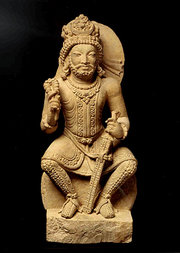
Figure in Sassanian dress North-western India,
probably Punjab Hills Late 6th/early 7th century Sandstone
The Sassanian empire of Persia, who were close contemporaries of the Guptas, began to expand into the northwestern part of ancient India (now Pakistan), where they established their rule. The mingling of Indian and Persian cultures in this region gave birth to the Indo-Sassanian culture, which fluorished in the western part of the Punjab and the areas now known in Pakistan as the North West Frontier Province and Baluchistan. The last Hindu kingdom in this region, the Shahis, also may have arisen from this culture.
Later, the Chola kingdom emerged in northern Tamil Nadu, and the Chera kingdom in Kerala. The ports of southern India were involved in the Indian Ocean trade, chiefly involving spices, with the Roman Empire to the west and Southeast Asia to the east. In the north, the first of the Rajputs, a series of kingdoms which managed to survive in some form for almost a millennium until Indian independence from the British.
Harsha's Empire
King Harsha of Kannauj succeeded in reuniting northern India during his reign in the 7th century. His kingdom collapsed after his death. From the 7th to the 9th century, three dynasties contested for control of northern India: the Pratiharas of Malwa and later Kannauj; the Palas of Bengal, and the Rashtrakutas of the Deccan.
The Chalukyas and Pallavas
The Chalukya Empire ruled parts of southern and central India from 550 to 750 (from Badami, Karnataka)and again from 970 to 1190 (from Kalyana, Karnataka). The Pallavas of Kanchi were their contemporaries to the south. Over a period of roughly a century, the two kingdoms fought a series of low-intensity wars, each conquering the other's capitals at various points. The kings of Sri Lanka and the Keralan Cheras rendered support to the Pallavas, while the Pandyas rendered support to the Chalukyas. Whilst the northern concept of a pan-Indian empire had collapsed at the end of Harsha's empire, the ideal instead shifted to the south. The two dynasties were responsible for some of the greatest examples of both rock-cut and free-standing temples.
Chola Empire
The Cholas emerged as the most powerful empire in the south in the 9th century and retained their pre-eminent position until the 13th century when the Vijayanagar empire was founded. The Cholas, like the Chalukyas and Pallavas before them, and the Vijaynagar after them, were responsible for some of India's finest monuments, and being located on the south tip of the peninsula, ruled Sri Lanka, and culturally dominated most of South East Asia, where the Hindu Srivijaya and Khmer empires of Indonesia and Cambodia used south Indian temple design. The Chola Navy was the most powerful for its time having conquered the neighboring island of Lanka and other areas across the Bay of Bengal.
History of South India
Pratiharas -- Palas -- Rashtrakutas
The Pratiharas, also called the Gurjara-Pratiharas were an Indian dynasty who ruled kingdoms in Rajasthan and northern India from the sixth to the eleventh centuries. The Pala Empire controlled Bihar and Bengal, from the 8th to the 12th century. The Rashtrakutas of Malkhed (Karnataka) were a dynasty which ruled the Deccan during the 8th-10th centuries after the end of Chalukya rule. Each three kingdoms vied for north Indian domination around the same time that the Cholas were flourishing in the south.
The Rajputs
The first recorded Rajput kingdoms emerged in Rajasthan in the 6th century, and Rajput dynasties later ruled much of northern India, including Mewar (Sisodias), Gujarat (Solankis), Malwa (Paramaras), Bundelkhand (Chandelas), and Haryana (Tomaras). The Pallava dynasty of Kanchipuram ruled southeastern India from the 4th century to the 9th century. The Pratihara ruled northern India before the Rajputs. Various other dynasties such as the Yadav, Chera, Hoysala of Halebidu, Sena and Pala controlled various empires of their own.
Vijayanagar Empire
The brothers Harihara and Bukka founded the Karnataka Empire, also known as the Vijayanagara Empire, in 1336. The Vijayanagara empire prospered during the reign of Krishnadevaraya. It suffered a major defeat in 1565 but continued for another century or so in an attenuated form. Southern Indian kingdoms of the time expanded their influence as far as Indonesia, controlling vast overseas empires in south east Asia. The Hindu dynasty came into conflict with Islamic rule (the Bahmani Kingdom) and the clashing of the two systems, the prevailing indigenous Hindu/Muslim religion, which caused a mingling of the indigenous and foreign culture that left lasting cultural influences on each other. The later Mughal rule also saw such influences of Gujarati and Rajasthani culture contributing towards this.
The Islamic Sultanates
After the Arab-Turkic invasion of India's ancient northern neighbor Persia, various short lived Islamic empires invaded and spread across the subcontinent over a period of 1000 years. Prior to Turkish invasions, Muslim trading communities flourished throughout coastal South India, particularly in Kerala.
Delhi Sultanate
In the 10th and 11th centuries, Turks and Afghans invaded parts of northern India and established the Delhi Sultanate at the beginning of the 13th century. The Slave dynasty managed to conquer large areas of northern India approximate to the ancient extent of the Guptas, while the Khilji Empire was also able to conquer most of central India, but they were ultimately unsuccessful in conquering most of the subcontinent, until the onset of the Mughals.
The Mughal Era
Mughal Empire
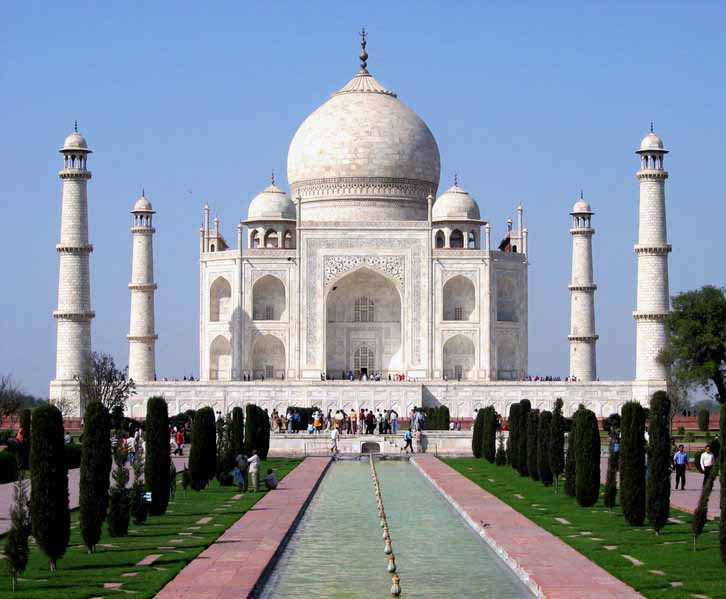
Taj Mahal
Other Mughal Architecture
In 1526, Babur, a Timurid descendant of Timur, swept across the Khyber Pass and established the Mughal Empire, which lasted for over 200 years. The Mughal Dynasty ruled most of the Indian subcontinent by 1600; it went into a slow decline after 1707 and was finally defeated during the Indian rebellion of 1857. This period marked vast social change in the subcontinent as the Hindu majority were ruled over by the Mughal emperors, some of whom showed religious tolerance, while others liberally patronized Hindu culture, and some of whom destroyed historical temples and imposed taxes on non-Muslims. During the decline of the Mughal Empire, which at its peak occupied an area slightly larger than the ancient Mauryan Empire, several smaller empires rose to fill the power vacuum or themselves were contributing factors to the decline.
The Maratha Confederacy
The Maratha Kingdom was founded by Shivaji in 1674 when he annexed a portion of the Bijapur Sultanate. Shivaji had declared war upon the oppressive Mughal dynasty in order for the Hindu majority of the subcontinent to once again be free of the various Islamic dynasties that had appeared over the last 600 years. By the 18th century, it had transformed itself into the Maratha Confederacy under the rule of the Peshwa. By 1760, the Empire had stretched across practically the entire subcontinent. This expansion was brought to an end by the Maratha's defeat by an Afghan army at the Third Battle of Panipat in 1761. The last Peshwa, Baji Rao II, was defeated by the British in the Third Anglo-Maratha War.
The Kingdom of Mysore
The Kingdom of Mysore was a kingdom of southern India, which was founded around 1400 CE by the Wodeyar dynasty. The rule of the Wodeyars was interrupted by Hyder Ali and his son Tippu Sultan. Under their rule Mysore fought a series of wars sometimes against the combined forces of the British and Marathas, but mostly against the British with some aid or promise of aid from the French. After the death of Tippu Sultan in the Fourth War of Mysore in 1799, the Wodeyar dynasty regained limited power as a Princely State under the British. The Kingdom of Mysore became part of the modern day, Indian state of Karnataka.
The Punjab - Sikh Empire
The Punjabi kingdom, ruled by members of the Sikh religious movement was a political entity that ruled the region of modern day Punjab. Founded by the ten Gurus of the Sikh faith, it expanded its borders during the reign of Maharaja Ranjit Singh at the height of the Sikh Empire to include surrounding areas like Kashmir and Peshawar, and was among the last areas of the subcontinent that was conquered by the British. The Anglo-Sikh wars marked the downfall of the Sikh Empire.
Company Rule
Colonial India and European Colonies in India
Vasco da Gama's discovery of a new sea route to India in 1498 paved the way for European colonization of India. The Portuguese set up bases in Goa, Daman, Diu and Bombay. They remained the longest colonial rulers for 500 years till 1962. The British established their first outpost in South Asia in 1619 at Surat on the northwestern coast of India, arriving in the wake of Portuguese and Dutch visitors. Later in the century, the British East India Company opened permanent trading stations at Madras, Bombay, and Calcutta, each under the protection of native rulers.
French India
The French set up base along with the British in the 17th century. They occupied large parts of southern India. However subsequent wars with the British, led to the loss of almost all their territory. They however retained the colonies of Pondicherry -(Pondicherry, Karaikal, Yanam, and MahŽ.) and Chandernagore. Pondicherry was ceded to India in 1950.
The Dutch did not have a major presence in India. The towns of Travancore were ruled by the Dutch. However they were more interested in Ceylon (now Sri Lanka) and their prize of the Dutch East Indies (now Indonesia). They were responsible for training the military of the princely state of Kerala. In 1845, the Danish colony of Tranquebar was sold to the United Kingdom.
The British established a foothold in Bengal when the British soldiers, funded by the East India Company, and led by Robert Clive, defeated Nawab Siraj Ud Daulah in the Battle of Plassey in 1757 and plundered the Bengali treasure. Bengal became a protectorate, and then directly went under the rule of East India Company. The British East India Company monopolized the trade of Bengal. The Bengali craftsmen were inevitably fixed at foreign posts of the Company, where they were obliged to render their labour at minimal compensation while their collective tax burden increased harshly. The result was the famine of 1769 to 1773 in which 10 million Bengalis died, followed almost a century later by the catastrophic Great Calamity period, resulting in part from an extension of similar policies, in which up to 40 million Indians perished from famine amidst the collapse of India's native industries and skilled workforce.
By the 1850s Britain controlled most of the Indian sub-continent, which included present-day Pakistan and Bangladesh. From 1830, the defeat of the Thugs played a part in securing establishing greater control of diverse Indian provinces for the British.
The Indian rebellion of 1857 in the north, led by mutinous Indian soldiers, was crushed by the British. It is also called the first war of Indian independence. In the aftermath all political power was transferred from the East India Company to the Crown, which began administering most of India directly. It controlled the rest through local rulers.
In the late 19th century "British India" took its first steps toward self-government with the appointment of Indian councillors to advise the British viceroy, and the establishment of provincial Councils with Indian members; the British subsequently widened participation in legislative councils. Beginning in 1920, Indian leaders such as Mohandas K. Gandhi (also known as Mahatma (Great Soul) Gandhi) and Subhas Chandra Bose transformed the Indian National Congress into a mass movement to campaign against British colonial rule. The movement eventually succeeded in bringing independence to the people of the Indian subcontinent, by means of parliamentary action and non-violent resistance and non-cooperation. Following the division of India into the secular Republic of India and the Islamic Republic of Pakistan in August 1947, rioting broke out between Sikhs, Hindus and Muslims in several parts of India, including Punjab, Bengal and Delhi, leaving some 200,000 dead. Also, this period saw the largest mass migration ever recorded in modern history, with a total of 12 million Hindus and Muslims moved between the newly created dominions of India and Pakistan.
Since independence, India has fought a number of wars against its neighbours, most notably four wars against Pakistan, and one against China. It also detonated a nuclear device in 1974 and became a Declared nuclear state in 1998 following a series of tests. From a socialist-inspired economy to the early 1990s , India continued to make slow progress away from the state the British had left the country in, however, it was only after extensive economic reforms in the early 90s (initiated by Present Prime minister of India Manmohan Singh) that India's economy began to grow at a high rate. Today, in the 21st century, India is considered an emerging economic superpower, and is currently the tenth largest economy in terms of gross GDP, and 4th largest when accounting for purchasing power parity.
Since independence, India has fought three major wars and one minor war with Pakistan (see Indo-Pakistani Wars). The Indo-Pakistani War of 1947 started over the control of Kashmir. The Indo-Pakistani War of 1965 was also fought over Kashmir. In 1971, India hosted refugees from erstwhile East Pakistan and helped the Bangladeshi freedom fighters (Mukti Bahini) with resources and training during the Bangladesh Liberation War. During the final stages of that war, India became directly involved in the Indo-Pakistani War of 1971, which ultimately resulted in Pakistan's defeat and the independence of Bangladesh. India also fought a border war with China in 1962 (see Sino-Indian War).
As well as being a declared nuclear state, India has an advanced space program designed to benefit the country economically, rather than merely create prestige. In the 1990s, following economic reform from the socialist-inspired economy of post-independence India, the country began to experience rapid economic growth, as markets opened for international competition and investment. In the 21st century, India is an emerging economic power with vast human and natural resources, and a huge knowledge base. Economists predict that by 2050, India will be among the top three economies of the world.
History of India










